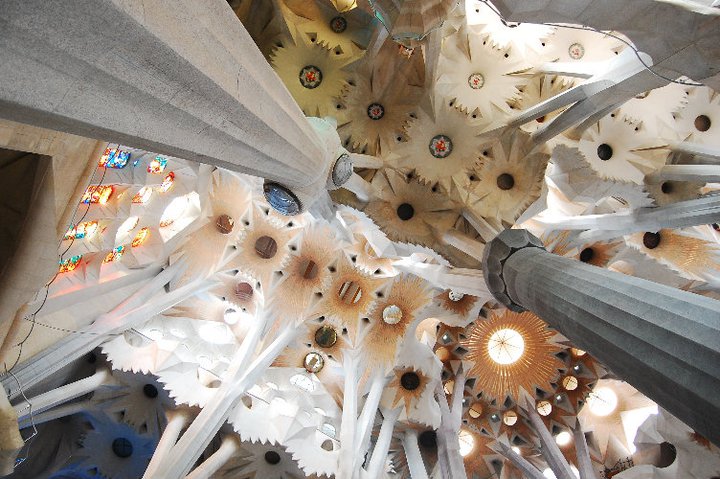Sagrada Familia Consecration
/"Gaudí was not just an architectural genius. He was a liturgical one too. ... After that it looked like a normal papal Mass -- only in a church of jaw-dropping beauty and brilliance, in a liturgical space that came closer to God's own creation than anything attempted before in architecture."Austen Ivereigh in America Magazine
This morning Pope Benedict XVI dedicated the Expiatory Temple of Sagrada Familia in Barcelona and elevated it to a minor basilica. This is the first church dedicated by Pope Benedict in what Vatican Press Office Director Fr. Federoco Lombardi described as "One of the most joyful moments in his life as Pope." The exterior of the building, designed by Antoni Gaudí and begun in 1882, is still incomplete, but the interior is now complete enough to serve as a functioning church.
"What do we do when we dedicate this church? In the heart of the world, placed before God and mankind, with a humble and joyful act of faith, we raise up this massive material structure, fruit of nature and an immense achievement of human intelligence which gave birth to this work of art. It stands as a visible sign of the invisible God, to whose glory these spires rise like arrows pointing towards absolute light and to the One who is Light, Height and Beauty itself." Pope Benedict XVI homily (full text)
From "Rome Reports" comes the following coverage. The video of the event brings to life the dramatic interior in ways the still photographs do not convey. I am used to seeing elements of the building presented as relief sculptures and purely formal design components. What is seen here is evidence of an integrated whole supporting and enlivening the liturgy.
[youtube_sc url="http://www.youtube.com/v/WSxcQOZPyCM" modestbranding="1" autohide="1"]
Another video with the full entrance:
[youtube_sc url="http://www.youtube.com/v/iYHXskNwbpg" modestbranding="1" autohide="1"]
Also noteworthy is the fact that the Congregation for the Causes of Saints is currently reviewing the cause of sainthood for the architect Antoni Gaudí. Started in 1992, this cause has always struck me as extremely odd based on my own architectural education. Pope Benedict's words about Gaudí in his homily likewise confused me somewhat.
Architects and architectural historians (at least of the generation who were my teachers) tend to treat Gaudí in any of three cases. First, he is the lone-genius proto-modern martyr-hero visionary ushering in the coming triumph of high modern design conveniently lumped in with the art nouveau. Second, he is the nature-worshiping vegetarian designer of organic forms. Or third, he is the oppressed nationalist and separatist activist champion of local and vernacular design. Obviously the latter two are the more acceptable in contemporary scholarship. This is all worlds away from the Pope's description of "a creative architect and a practising Christian who kept the torch of his faith alight to the end of his life, a life lived in dignity and absolute austerity." I was aware that Gaudí was in fact Catholic, but this was in no way credited as an impetus for his work.
The myth circulates that Gaudí died in a streetcar accident because he looked up to admire his own work while crossing the street. I do not say "myth" in the colloquial sense of something that is untrue, but that this story exists and is retold to reaffirm the modern conception of the genius auteur as heavily vested in his own individuality. It may be to a fault, but it is supposedly the perpetually forgivable fault and the price of genius. But we know from the great Christian aesthetic thinkers of the 20th century (I appeal to the likes of Pope John Paul II, Hans urs von Balthasar, Tarkovsky, Tolstoy, Tolkien et al. here) that this is not the nature of art and Beauty. As Pope Benedict today reiterated: "Beauty also reveals God because, like him, a work of beauty is pure gratuity; it calls us to freedom and draws us away from selfishness." So defined it is not difficult to understand why "beauty" left the lexicon of architects during Gaudí's lifetime.
So was living in "absolute austerity" in the crypt of the church a matter of selfish pride and obsessive self-dedication?
Was it delusions of grandeur which made him claim that "Saint Joseph will finish this church" or an actual faith in the statement? The academy would never allow it, especially now that Builder of the Holy Family seems more likely than ever to get it done.
"A church [is] the only thing worthy of representing the soul of a people, for religion is the most elevated reality in man." Antoni Gaudí
As to the nature-worshiping, nationalist-activist, and proto-modernist story lines? They are true insomuch as they can compartmentalize and attempt to explain (sometimes explain away) an architect with such a complex body of work outside the mainstream narrative of history. They are only able to be integrated in light of the more important reality, an integration Pope Benedict articulated in his remarks today:
"In this place, Gaudí desired to unify that inspiration which came to him from the three books which nourished him as a man, as a believer and as an architect: the book of nature, the book of sacred Scripture and the book of the liturgy. In this way he brought together the reality of the world and the history of salvation, as recounted in the Bible and made present in the liturgy. He made stones, trees and human life part of the church so that all creation might come together in praise of God, but at the same time he brought the sacred images outside so as to place before people the mystery of God revealed in the birth, passion, death and resurrection of Jesus Christ. In this way, he brilliantly helped to build our human consciousness, anchored in the world yet open to God, enlightened and sanctified by Christ."

